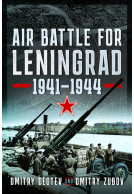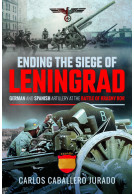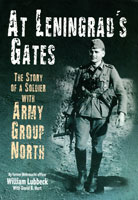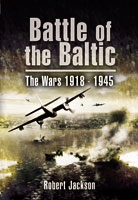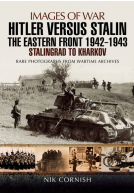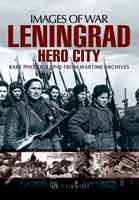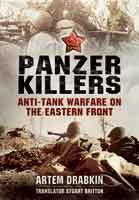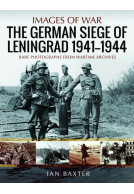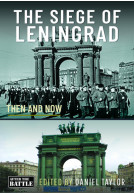
Discover our recommended reading about the Siege of Leningrad.
Save 30% off RRPs until 31/03/24.
Recommended reading
Air Battle for Leningrad (Hardback)
1941–1944
The Siege of Leningrad was one of the most brutal battles of the Second World War. The second largest and most populous city in the Soviet Union, Leningrad, now St. Petersburg, was one of the three priority targets of the German invasion, Operation Barbarossa. A total of 333 large military factories were concentrated in Leningrad and, accordingly, 565,000 workers lived there, producing tanks, aircraft, artillery and warships.On 10 July 1941, German tank divisions, having broken through the front south of the city of Pskov, reached the town of Luga. From there, Hitler’s forces had just over 110 miles to go to Leningrad. Meanwhile, the city was feverishly preparing for defence. Stalin’s deputies, Zhdanov and Voroshilov, planned to use the entire combat-ready population of Leningrad for that purpose.
Believing that the city would soon be captured by the Germans, Stalin ordered the immediate evacuation of military factories and skilled workers from Leningrad to the East. Before the city was completely blockaded, most of the valuable equipment had been removed. However, the remaining civilian population, including about 400,000 children, were left to their fate.
In early September 1941, German divisions supported by the Luftwaffe’s VIII Fliegerkorps, captured the town of Shlisselburg. Leningrad was now cut off from the rest of the Soviet Union. Hitler believed that the city would soon echo to the sound of German jackboots.
Leningrad, however, did not give up. In the autumn of 1941, the Wehrmacht did not have enough forces to take the city and for three long years the main means of fighting its defenders were the Luftwaffe and long-range artillery. In September 1941, when the systematic bombing and shelling began, many thousands of families tried to leave Leningrad, but nearly all of the escape routes were cut off. Food supplies in the city sharply decreased.
In this book the authors explore the full story of the German and Soviet aerial battles in the Leningrad sector during the siege. There are devastating details of the bombing of the starving population, numerous attempts by the Luftwaffe to destroy the Red Baltic Fleet, and air attacks against the ‘Road of Life’, along which vital food and ammunition were delivered to the city, and combats in the skies over Leningrad and its surroundings. Revealing what was happening in the air and on the ground, as well as in the German and Russian headquarters, the authors explain why, in spite of numerous successes, the Luftwaffe failed to help force the surrender of Leningrad.
Battle of the Cities (Hardback)
Urban Warfare on the Eastern Front
The Stalingrad battle and the Leningrad siege were just two of the brutal, devastating urban conflicts that marked the awful struggle between Germany and the Soviet Union during the Second World War. The cities were strategic fixed points in the sweeping advances and retreats of the opposing armies across eastern Europe. Yet no one has concentrated on these city battles before or has sought to tell the story of the campaigns through the fighting that took place in and around them. That is Anthony Tucker-Jones’s purpose in this concise and vivid history of the urban war on the Eastern Front.Early in the war, during the Wehrmacht’s crushing offensives of 1941 and 1942, the Red Army was forced out of a series of key cities. Moscow was threatened, Leningrad surrounded. Then, after the climactic battle at Stalingrad, the Red Army with increasing confidence, speed and power drove the Germans from the Soviet and East European capitals they had occupied. The final urban battles were fought in Germany's cities, culminating in Berlin.
As he traces the course of the fighting for each city, Anthony Tucker-Jones looks at the local circumstances, the opposing forces, the strategic significance and the tactics employed. He focuses not only on the destruction and cruelty of such warfare, but on the heroism displayed on both sides and on the fate of the civilians who found themselves on the front line.
Ending the Siege of Leningrad (Hardback)
German and Spanish Artillery at the Battle of Krasny Bor
The Battle of Krasny Bor in 1943 was part of the Soviet Red Army's efforts to lift the blockade of Leningrad, one of the longest and most destructive in history.Previous works on the Battle of Krasny Bor have focused primarily on the infantry involved, especially when using veteran testimonies, and the use of artillery has been conspicuously absent.
This book aims to put the reader right in the heart of the battle, describing the action from an artilleryman's point of view, seeing it fundamentally as a duel between the Soviet and German-Spanish soldiers.
Leningrad Under Siege (Paperback)
First-hand Accounts of the Ordeal
Leningrad was under siege for almost three years, and the first winter of that siege was one of the coldest on record. The Russians had been taken by surprise by the Germans' sudden onslaught in June 1941.This book tells the story of that long, bitter siege in the words of those who were there. It vividly describes how ordinary Leningraders struggled to stay alive and to defend their beloved city in the most appalling conditions. They were bombed, shelled, starved and frozen. They dug tank-traps and trenches, built shelters and fortifications, fought fires, cleared rubble, tended the wounded and, for as long as they had strength to do so, buried their dead. Many were killed by German bombs or shells, but most of them died of hunger and cold.
Based on interviews with survivors of the siege and on contemporary diaries and personal memoirs. The primary focus is on three people: a young mother with two small children, a boy of sixteen at the outbreak of war, and an elderly academic. We see the siege through their eyes as its horrors unfold and as they struggle to survive.







